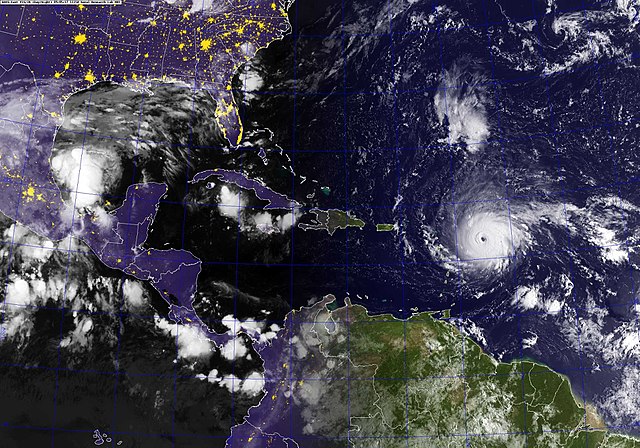It’s an eerie experience. You’ve just heard that another hurricane has formed in the Atlantic, and that it’s headed toward land. You search for NOAA’s National Hurricane Center website so you can see the forecast path for the storm. You’re horrified at the implications, and you bookmark the site. You check in every few hours to see forecast updates. You know in general terms what’s coming—devastation for the lives of thousands, maybe millions of people. Then a few days later you begin to see the sad, shocking photos and videos of destruction.
Thanks to modern science and technology—satellites and computers—we have days of warning before a hurricane hits. That’s extremely helpful: while people can’t move their houses and all their possessions, they can board up windows, stock up on food and water, and perhaps get out of town. Huge storms are far less deadly than they would be if we didn’t have modern weather forecasting.
Science and technology have also enabled us to forecast “storms” of another kind. Using computers and data about population, energy, pollution, natural resources, and economic trends, it’s possible to generate scenarios for the future of industrial civilization. The first group of researchers to do this in 1972, found that the “base case,” or most likely scenario, showed essentially the collapse of society: in the early-to-middle decades of the 21st century, industrial production would peak and begin to decline sharply; so would food production and (with a lag of a few years) population. For decades scientists have been updating the software and plugging in new and better data, but ever-more-powerful computers keep spitting out the same base-case scenario.
One of the factors the 1972 researchers thought would be of increasing significance was climate change. Now, 45 years later, many thousands of scientists around the world are feeding their supercomputers data on carbon emissions, carbon cycles, carbon sinks, climate sensitivity, climate feedbacks, and more. They likewise see a “hurricane” on the way: we are altering the chemistry of the Earth’s atmosphere and oceans so significantly, and so quickly, that dire consequences are almost certain, if not already here. Later this century we’ll see storms, droughts, heat waves, and wildfires like none on record. Agriculture will likely be impacted severely.
Ever since I read the 1972 report on Limits to Growth, I’ve had that same eerie feeling as when looking at the charts on the NOAA website. Only the feeling is deeper, more pervasive, and (of course) long-lasting. A storm is coming. We should batten down the hatches.
But, 45 years down the line, the storm is no longer far away. In fact, the photos and videos of destruction are starting to come in. No nations have bothered to make sensible efforts to minimize the storm’s impact by reducing fossil fuel consumption, stabilizing population at 1970s levels, or reconfiguring their economy so it doesn’t require continuous growth in resource and energy usage. Why didn’t we do those sensible things, even though we had plenty of warning?
Our failure to respond has a lot to do with the long time lag. We humans are much better at dealing with immediate threats than ones years ahead. In effect, we have an internal discount rate that we apply to possible disasters, depending on their temporal proximity.
Given a long-term threat, some of us are more likely to develop complicated rationales for doing nothing. After all, averting a really big disaster may require substantial inconvenience. Getting out of the way of a hurricane might mean packing up your most treasured belongings, driving a couple of hundred miles, and trying to find a motel that’s not already overbooked (that is, if you are among the fortunate with the resources to do so). Minimizing the threat of global overshoot might mean changing our entire economic system—from how we grow food to how we get to work and what kind of work we do. Escaping the hurricane engages our survival instincts; we don’t have time to doubt the weatherman. But given a few decades to think about it, we might come up with lots of (ultimately wrongheaded but carefully reasoned nonetheless) reasons why our current economic system is really just fine, and why global overshoot really isn’t a threat.
Those of us who aren’t so good at coming up with such rationalizations are stuck with the eerie feeling that something very bad is about to happen—maybe in Florida this weekend, maybe everywhere before long. Here’s my recommendation, based on a few decades of watching all kinds of storm charts: please pay attention to the weatherman. Stop finding reasons why you really don’t have to change or prepare. Make your way to higher ground. And be sure to help your neighbors.
Image: A GOES satellite image showing Hurricane Irma in the Atlantic Ocean, North of Venezuela. The storm is a category 5 hurricane on the Saffir-Simpson hurricane wind scale. 5 September 2017. Source US Navy. Via Wikimedia Commons.






